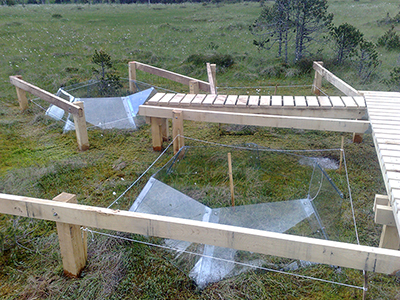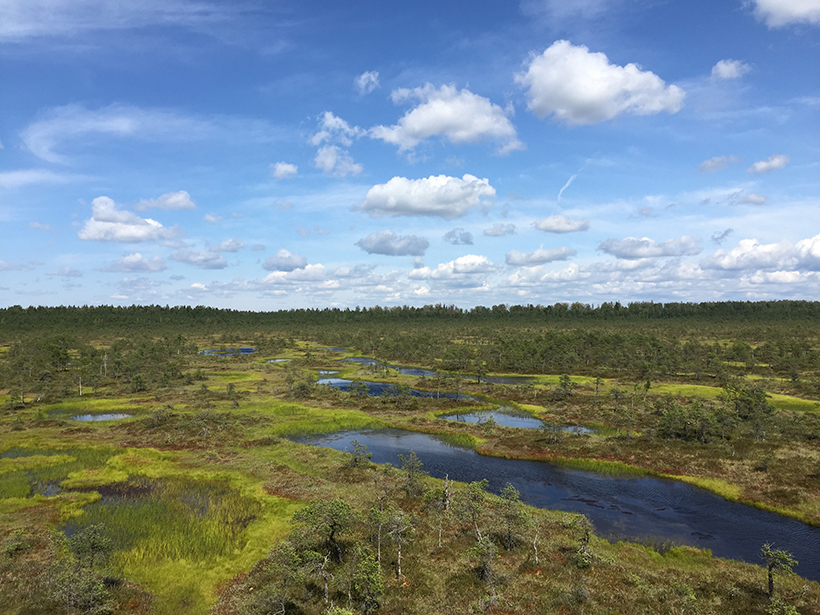Some boreal peatlands may prove more resilient to climate change than previously thought and could thrive as major carbon sinks even as northern regions become drier and less hospitable, new research suggests.
Maintaining a diversity of moss species in northern zones could help these landscapes withstand some effects of climate change.
By their nature, peat bogs and other mossy wetlands require some level of moisture to stay intact. If they dry up, through either prolonged drought or drainage for land development, the peat mosses die, and other plants can infiltrate and morph the landscape.
Climate projections suggest that some boreal regions will become warmer and drier with climate change and that this transformation will jeopardize peatland health and capacity to store carbon. But new research from a team based in France suggests that two common peat moss species have considerably different tolerances for different levels of warming and drying, suggesting that some species could take the place of others as conditions shift. Research suggests that maintaining a diversity of moss species in northern zones could help these landscapes withstand some effects of climate change, the team reports in the journal Global Change Biology.
“It was quite surprising to see that,” said Vincent Jassey, an ecologist at Université Toulouse III–Paul Sabatier in France and lead author on the paper.
These findings may have important implications for the future of global carbon storage, he added. All soils have the capacity to store some carbon, but peatlands impressively store roughly 30% of all soil carbon on the entire planet, even though they comprise less than 5% of Earth’s surface.
Carbon Sinks
Peatlands capture carbon so effectively because unlike most other plants, peat mosses don’t readily break down when they die. Instead, they build up underground, sometimes accumulating meters in depth over the course of thousands of years. This accumulation means that the carbon they suck out of the atmosphere during photosynthesis gets trapped underground rather than cycling back into the atmosphere.
Microbes struggle to decompose peatlands because the mosses contain complex compounds that are difficult to degrade and because they tend to generate highly acidic, low-oxygen environments—conditions that many microbes can’t withstand.
But once these peatlands lose water, oxygen creeps in, and microbial activity can rev up. The rootless plants may also struggle to gather enough water for photosynthesis during dry times.
Still, although prolonged drought certainly stresses bogs, a bit of warming actually promotes photosynthesis and growth in some peat moss species for the same reason that some plants grow better in a greenhouse.
Moss Species
To try to tease apart these compounding effects of warmer, drier conditions on peat mosses, Jassey and his team studied two common species, Sphagnum medium and Sphagnum fallax, under varying levels of temperature increase and moisture loss in the Jura Mountains of France.

They found that S. medium had the capacity to hold 3 times more water than S. fallax, thanks to larger water-storing tufts called capitula. S. fallax, however, experienced greater growth than S. medium did during warming. This result suggests that S. medium may tolerate more drought-prone regions during climate change, whereas S. fallax may succeed more readily in areas that experience more warming.
Matthias Peichl, a biogeochemist at the Swedish University of Agricultural Sciences who studies the role of peatlands in the global carbon cycle, finds these results interesting but not entirely surprising.
“It seems to make sense that given such a diverse species presence [of peat mosses], there would always be some that respond positively or negatively to any change,” said Peichl, who was not involved in the study. More than 350 species of peat moss exist around the world, including in some tropical regions.
But, Peichl added, understanding the true, lasting effects of climate change on these species would require a longer-term study because a plant’s response to short-term disturbance may differ from its response to more sustained change.
Hongjun Wang, a biogeochemist at Duke University who also studies the effects of drought on peatlands and wasn’t involved in the new study, agreed that these findings call for follow-up research. He also noted that peatlands can withstand only a certain threshold of change before they inevitably break down. A shift past that threshold, he said, “will change the peatland from a sink to a carbon source.”
Still, in the short term, Jassey said that his team’s findings offer a compelling argument to preserve peatlands and help these landscapes continue to stand as major carbon sinks.
“It shows that peatlands could be resistant to future climate change,” he said, “if we don’t disturb the ecosystem and we keep the diversity as it is.”
—Laura Poppick (@laurapoppick), Freelance Science Journalist
Citation:
Poppick, L. (2019), Resilient peatlands keep carbon bogged down, Eos, 100, https://doi.org/10.1029/2019EO135069. Published on 08 October 2019.
Text © 2019. The authors. CC BY-NC-ND 3.0
Except where otherwise noted, images are subject to copyright. Any reuse without express permission from the copyright owner is prohibited.

